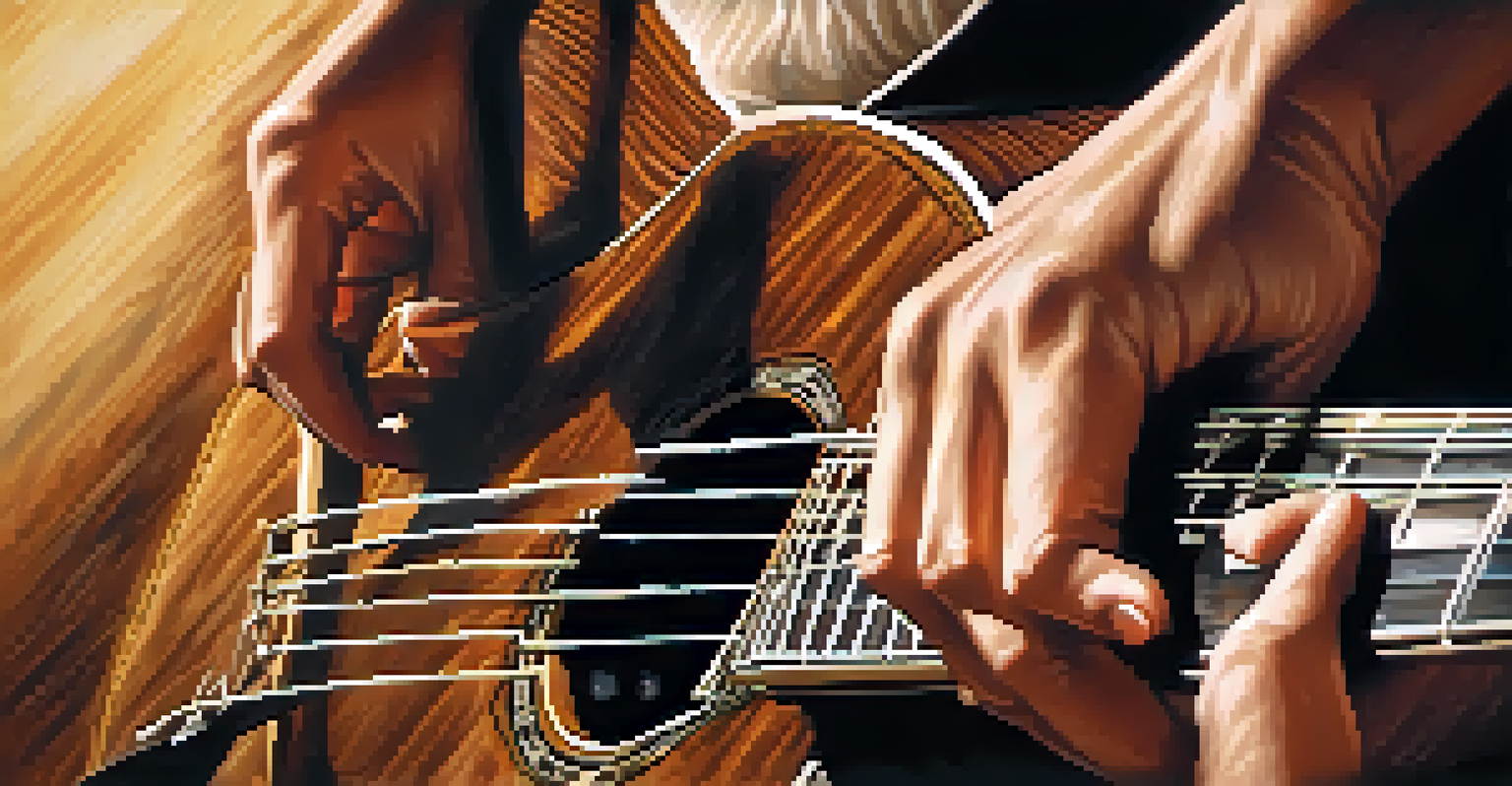The Role of Rhythm in Guitar Accompaniment for Singers

What is Rhythm in Music and Its Importance?
Rhythm is the heartbeat of music, providing structure and movement. It dictates how melodies unfold and maintains the listener's interest. Without rhythm, even the most beautiful melody can feel lifeless and unengaging.
Rhythm is everything in music. It is the heartbeat of the song.
Think of rhythm as the dance floor of a party; it sets the tempo and encourages everyone to join in. In guitar accompaniment, rhythm shapes the way singers express their emotions and connect with their audience. A well-defined rhythm can elevate a simple song into a captivating performance.
For singers, a strong rhythmic foundation helps them stay in sync with the guitar and enhances their vocal delivery. When the rhythm is solid, singers can focus on their performance rather than worrying about timing.
The Role of Strumming Patterns in Guitar Accompaniment
Strumming patterns are essential tools for creating rhythm in guitar playing. These patterns dictate how and when the strings are played, influencing the overall feel of a song. A simple up-and-down strumming pattern can evoke a relaxed vibe, while a more complex rhythm can create excitement.

For instance, consider the difference between a steady quarter-note strum and an intricate syncopated pattern. The former provides stability and predictability, while the latter adds flair and complexity. Singers can adjust their vocal delivery based on these changes, resulting in a dynamic performance.
Rhythm: The Heartbeat of Music
Rhythm provides the essential structure that keeps melodies engaging and allows performers to connect with their audience.
Ultimately, strumming patterns can either complement a singer's style or challenge them to rise to the occasion. Understanding how to use these patterns effectively makes guitarists better companions for singers.
Syncopation: Adding Interest to Guitar Accompaniment
Syncopation involves placing emphasis on unexpected beats, adding intrigue and excitement to music. This rhythmic technique can be a game-changer in guitar accompaniment, creating a unique groove that captures the listener's attention. It allows the guitarist to break free from predictable patterns.
Music is the shorthand of emotion.
Imagine a jazz guitarist who plays off-beat chords while a singer delivers a smooth melody. This interplay creates a captivating tension that draws the audience in. Syncopation can make even familiar songs feel fresh and innovative.
By incorporating syncopation into their playing, guitarists can inspire singers to explore new vocal interpretations, resulting in a more engaging performance. It encourages creativity and spontaneity, making every performance feel unique.
The Interaction Between Rhythm and Melody
Rhythm and melody are two sides of the same coin; they work together to create a cohesive musical experience. While melody captures the essence of a song, rhythm provides the framework that supports it. This relationship is especially important in guitar accompaniment for singers.
For example, a singer's melody might soar through a series of notes, but it's the underlying rhythm that gives it shape and direction. Guitarists can enhance this connection by adjusting their strumming or picking to match the singer's phrasing. This coordination fosters a deeper musical synergy.
Strumming Patterns Shape Songs
Effective strumming patterns dictate the feel of a song, enhancing the dynamic interaction between guitarists and singers.
When guitarists and singers collaborate effectively, they create a unified sound that resonates with audiences. This partnership is essential for crafting memorable performances that leave a lasting impression.
Creating Space: The Role of Silence in Rhythm
Silence is just as important as sound in music; it creates space and allows other elements to shine. In guitar accompaniment, knowing when to pause can enhance the overall rhythm, making the music more impactful. These moments of silence can build anticipation for the next note or lyric.
Consider a ballad where a guitarist intentionally leaves gaps between chords. This creates a sense of longing that complements the singer's emotional delivery. When used thoughtfully, silence can elevate a performance to new heights.
By incorporating moments of silence, guitarists help singers convey deeper emotions. This balance of sound and silence is crucial for creating a compelling musical narrative.
Rhythm as a Tool for Emotional Expression
Rhythm is a powerful tool for conveying emotions in music. Different rhythmic patterns can evoke various feelings, from joy to melancholy. Guitarists can use this to their advantage when accompanying singers, enhancing the emotional depth of a performance.
For example, a slow, steady rhythm may underscore a heartfelt ballad, while an upbeat tempo can energize a lively song. Singers can adapt their vocal delivery to match these emotional cues, creating a more resonant experience for the audience.
Silence Enhances Musical Impact
Moments of silence in music create space for emotional expression, making performances more compelling and resonant.
Ultimately, the rhythm sets the emotional tone, guiding both the guitarist and singer as they navigate the song together. This connection is vital for creating performances that resonate with listeners.
Practicing Rhythm: Tips for Guitarists and Singers
Practicing rhythm is essential for both guitarists and singers to build a strong musical foundation. Regularly playing with a metronome can help guitarists develop a consistent sense of timing. This practice not only improves their playing but also prepares them to accompany singers effectively.
Singers can benefit from rhythmic exercises, such as clapping or tapping out rhythms before adding their vocals. This approach allows them to internalize the rhythm and connect with the music more deeply. It also helps them stay in sync with guitarists during performances.

By prioritizing rhythm in their practice routines, both guitarists and singers can enhance their musical collaboration. This shared understanding of rhythm leads to more cohesive and engaging performances.